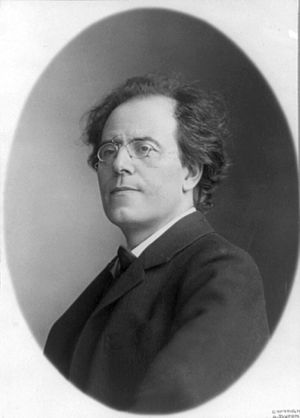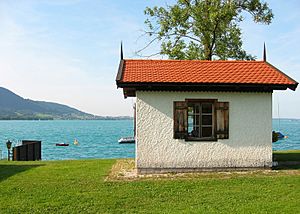Gustav Mahler facts for kids
Gustav Mahler (born July 7, 1860; died May 18, 1911) was a famous Czech-Austrian composer and conductor. He lived during the late Romantic period of music. Mahler wrote ten symphonies, though his tenth was not finished. He also created many collections of songs with orchestral accompaniment.
Mahler loved German folk songs. He found new ways to use these folk tunes in his large orchestral symphonies. One of his most important works is Das Lied von der Erde (The Song of the Earth). This piece combines songs with the symphonic form. Mahler was also a brilliant conductor. He helped make the Vienna Opera famous around the world.
Contents
Mahler's Life Story
Early Years and Education
Gustav Mahler was born on July 7, 1860. He was part of a Jewish family. He was the second of 12 children, but only six of them lived to be adults. His family moved to Iglau in 1860. His father worked hard and owned a distillery and seven taverns.
In Iglau, young Gustav heard many types of music. He listened to military music, folk music, and classical music. He learned to play the piano and performed in public in 1870. He also started to compose his own music.
In 1875, Mahler went to study at the Vienna Conservatory. He stopped studying piano to focus on composition and conducting. He was very interested in Wagner’s ideas about philosophy and politics. He also studied philosophy at the University of Vienna. To earn money, he taught music. His first major composition was a cantata called Das klagende Lied.
Starting His Conducting Career
Mahler's first job as a conductor was in Bad Hall, Austria. The opera company there was small and mostly performed light operetta. Mahler soon found a better job in Laibach (now Ljubljana). He conducted better music there but stayed only one year.
His next job was in Olmütz (now Olomouc). The singers were not very good at first. Mahler was strict, but he helped them improve. Then he got a job in Kassel. Here, he had to conduct many operettas. He also had an unhappy love affair with a singer. This experience inspired him to write a collection of orchestral songs called Lieder eines fahrenden Gesellen. He also began working on his first symphony.
In 1885, Mahler became a conductor in Prague. For the first time, he could conduct famous operas. These included works by Mozart, Wagner, and Beethoven. However, Mahler often argued with his colleagues. Because of this, he left Prague.
Mahler's next job was in Leipzig. The orchestra there was much larger and better. He worked with Arthur Nikisch, a very famous conductor. Mahler was often criticized because his conducting style was different from Nikisch's. When Nikisch was sick, Mahler conducted Wagner's Die Walküre and Siegfried. This showed everyone he was a great conductor. He also met the grandson of composer Carl Maria von Weber. Mahler completed an unfinished opera by Weber called Die Drei Pintos. He also worked on his own music and became friends with Richard Strauss.
Growing Famous: Budapest and Hamburg
In 1888, Mahler got a job at the Royal Opera in Budapest. The theater had money problems. The Hungarians wanted Mahler to make it a national opera. This meant using Hungarian singers as much as possible. However, there were not many good Hungarian singers. The opera company preferred light opera and ballet over German operas. Mahler was too busy with managing the theater to compose. So, he left Budapest. By this time, both his parents had passed away.
From 1891 to 1897, Mahler conducted in Hamburg. This opera company was world-class. Mahler quickly became famous internationally. He conducted many operas and orchestral concerts. He even conducted in London in 1892. He was invited back but declined, wanting time to compose. He spent his summers composing new music. During the theater season, he would finish and orchestrate his pieces. His Second Symphony was a huge success in Berlin in 1895.
After his parents died, Mahler supported his two sisters. He also encouraged his brother Otto to become a musician. Mahler continued to support his sisters until they married two famous brothers, Eduard and Arnold Rosé, in 1898 and 1902.
Mahler was becoming very well-known. In 1897, he toured to Moscow, Munich, and Budapest. He really wanted a job in Vienna. However, because he was Jewish, it was hard to find work there. So, he became a Roman Catholic. Soon after, he became Kapellmeister (music director) in Vienna.
Vienna Years: 1897-1907
In Vienna, Mahler quickly became famous for conducting Wagner and Mozart. His friend Guido Adler helped publish his First and Third Symphonies. Mahler took over from Hans Richter as conductor of the Philharmonic Concerts. Mahler attracted larger audiences, but he had disagreements with the musicians. They did not like his strictness or some of his unusual ideas. After an illness in 1901, he resigned.
He bought a house in Maiernigg in Carinthia. He spent his summers there composing. In 1901, he fell in love with Alma Schindler. Her father, Anton Schindler, was a famous landscape painter. Alma was almost 20 years younger than Mahler. She was studying composition, but Mahler asked her to stop. He wanted her to focus on being a good wife. This caused some difficulties in their relationship. In 1910, Mahler visited the psychoanalyst Sigmund Freud. Freud helped him understand his marriage and his creative side. After this, Mahler felt a deeper love for Alma.
At the Hofoper (Vienna Court Opera), Mahler conducted many great operas. He wanted to conduct Richard Strauss’s new opera Salomé, but the censors did not allow it. Still, Mahler's years in Vienna were very important. He had many new ideas. Through his wife, he met many artists, especially those from the Sezession movement. One artist, Alfred Roller, designed sets for a new production of Tristan und Isolde. Roller became Mahler’s main stage designer. Finally, Mahler could work with someone who shared his vision. Together, they staged many operas, including Fideleo, Don Giovanni, Die Entführung aus dem Serail, Le Nozze di Figaro, Die Zauberflöte, and Iphigénie en Aulide.
Mahler felt more secure after getting married. This made him more creative. He composed his Eighth Symphony very quickly. This symphony needs a huge orchestra and choir. That is why it is often called "Symphony of a Thousand." Mahler believed it was his best work.
Mahler never became a teacher, but he encouraged young composers. These included Arnold Schoenberg, Alban Berg, Anton Webern, and Alexander Zemlinsky. However, some music critics in Vienna were against Jewish people. They made things difficult for him. In 1907, his older daughter Maria died from scarlet fever. More bad news came when doctors found he had a serious heart condition. He was told to stop his favorite activities, like walking, cycling, and swimming. Mahler had done a lot for Vienna's culture, but he decided it was time to leave. The last piece he conducted in Vienna was his Second Symphony.
Final Years: New York and Europe
Mahler was invited to America to conduct at the Metropolitan Opera in New York City. It was very different from Europe. Instead of working with a team of singers, the Metropolitan Opera featured great operatic stars. Mahler did not try to change this. He even agreed to make cuts to Wagner operas. Later, he was invited to be the conductor of the New York Philharmonic. He then resigned from the Metropolitan Opera. He conducted there one last time as a guest.
In 1909, he finished his Ninth Symphony. He was very busy conducting in Europe. In January 1911, he conducted his Fourth Symphony in New York. Then he became ill and decided to return to Vienna. He arrived on May 12 but died a few weeks later, at the age of 50.
Mahler's Music Style
Mahler was one of the last composers in the great German and Austrian music tradition. Many German composers, like Beethoven, wrote great symphonies. But Mahler found new things to say in his music. His symphonies often have long, flowing melodies. He used folk songs and new sounds in the orchestra.
Mahler worked in the theater for most of his life. This influenced his music. For example, his Symphony No.4 starts in a happy key (G major). This part describes early life. It ends in E major, where a soprano singer sings about heavenly joys.
Mahler became very interested in German folk songs. He composed several sets of orchestral songs. He used poems from a collection called Des Knaben Wunderhorn (The Boy’s Magic Horn). These songs were originally medieval. But Mahler made them sound very different by adding his own personality. The style of his songs can be heard in his symphonies. Four of his symphonies (numbers 2, 3, 4, and 8) include singing. He wrote nine symphonies and started a tenth, but he died before finishing it.
Mahler was a great orchestrator. This means he was skilled at writing music for different instruments in an orchestra. Some of his later works need a very large orchestra. He often used unusual effects. For example, in his First Symphony, a double bass plays very high notes, with timpani drums playing along.
His set of orchestral songs Das Lied von der Erde (The Song of the Earth) is like a symphony. But he did not call it a symphony. This was because of superstitious reasons. Several great composers, including Beethoven, had written nine symphonies and then died.
Mahler as a Conductor
As a conductor, Mahler had a huge impact on music in Europe. He often conducted his own works. When he conducted music by other composers, he played it according to his own ideas. He even changed the orchestration of some works by Beethoven. He wanted the music to sound very clear. He was not the kind of conductor who tried to make the music sound exactly as the composer might have intended.
- The New Grove Dictionary of Music & Musicians, ed. Stanley Sadie, 1980; ISBN: 1-56159-174-2
Images for kids
-
Mahler was influenced by Richard Wagner's operas.
-
Mahler's home in Leipzig, where he composed his First Symphony
-
Hans von Bülow, a conductor who admired Mahler
-
Alma Schindler, who married Mahler in 1902
-
A bronze bust of Mahler by Auguste Rodin, 1909
See also
 In Spanish: Gustav Mahler para niños
In Spanish: Gustav Mahler para niños




















